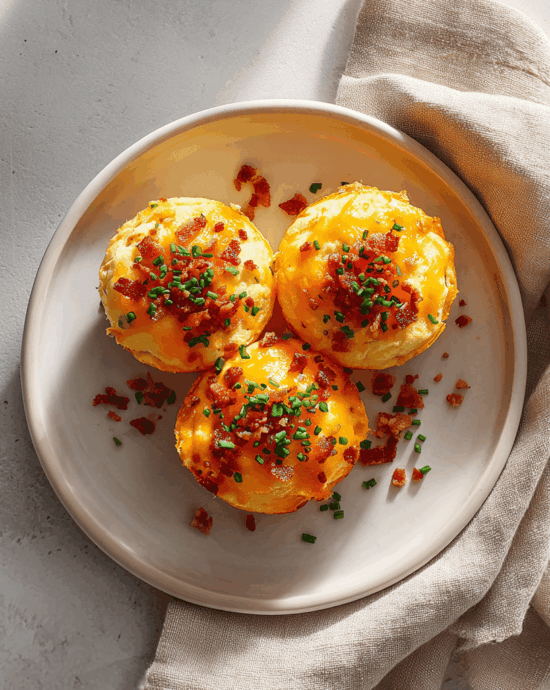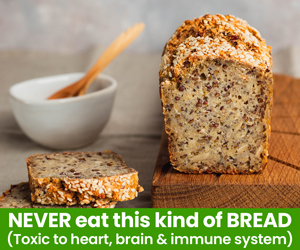Gather these items before you begin:
- Blender
- 12-cup standard muffin tin or silicone mold
- Large baking dish (for water bath)
- Mixing bowl
- Spatula
- Prepare Oven
Place a large baking dish on the bottom rack of your oven and fill it with about an inch of hot water. Preheat the oven to 325°F (160°C). Generously grease a 12-cup muffin tin.
- Blend Mixture
In a blender, combine the eggs, cottage cheese (or cream cheese), heavy cream, salt, and pepper. Blend on high for 30-45 seconds, until the mixture is completely smooth and frothy.
- Assemble Bites
Pour the blended egg mixture evenly into the 12 muffin cups, filling each about three-quarters full. Sprinkle the crumbled bacon, shredded cheese, and optional chives evenly over the top of each cup.
- Bake Gently
Carefully place the muffin tin on the center rack of the preheated oven, above the water bath. Bake for 22-28 minutes, or until the centers are just set and no longer jiggly.
- Cool and Serve
Remove the tin from the oven and let the egg bites cool in the pan for at least 10 minutes before running a knife or spatula around the edges to remove them. They will deflate slightly as they cool.
- Calories:295
- Total Carb:3 g
- Net Carb:3 g
- Fiber:g
- Fat:23 g
- Protein:19 g
- Sugar:2 g
The Simple Comfort of Morning Eggs

The smell of eggs cooking is a universal signal that the day is beginning. It’s a simple, honest aroma that promises substance and comfort. For many, the modern version of this morning ritual is a quick stop for a pair of sous-vide egg bites, those perfectly round, tender discs of protein that fit neatly in one hand. They are a small convenience in a busy world.
These little bites feel like a recent invention, a product of coffee shop culture. But their soul is much older. They are descendants of classic crustless quiches and mini frittatas, dishes born from a need to turn simple farm staples like eggs, cheese, and cream into something satisfying and portable. The idea of baking eggs in individual portions has been around for generations, a practical way to serve a crowd or prepare food for the week ahead.
The Hidden Hurdle in Modern Egg Bites
The problem with the popular coffee shop egg bites is what you don’t see. To achieve that signature smooth texture and long shelf life, many commercial recipes include ingredients that are not friendly to a ketogenic diet. Modified corn starch, rice starch, and various sugars are often used as thickeners and preservatives.
These additives introduce unnecessary carbohydrates that can disrupt ketosis. Even the types of milk used can be higher in sugar than what is ideal. This turns a seemingly perfect low-carb breakfast into a source of hidden carbs, making it a challenge for anyone carefully managing their intake. The convenience comes at a dietary cost.
A Keto Answer to the Morning Rush
This is where the homemade keto egg bites recipe shines. By taking control of the ingredients, you create a breakfast that truly aligns with a low-carb lifestyle. These bites are packed with high-quality fats and protein from eggs, cheese, and cream, providing sustained energy without the blood sugar spike associated with carb-heavy meals.
Making your own low carb egg bites is about more than just avoiding carbs. It’s about choosing better ingredients. You can use organic eggs, high-quality sugar-free bacon, and full-fat cheeses. This simple breakfast becomes a powerful tool for meal prepping, ensuring you have a healthy, satisfying option ready for those mornings when time is short.
Smart Swaps for a Superior Bite
The key to transforming a standard egg bite into a keto-friendly one lies in a few smart ingredient swaps. The starches used in commercial versions are replaced with natural, low-carb thickeners. Full-fat cream cheese or cottage cheese are excellent choices. They not only add a rich flavor but also create a wonderfully smooth and dense texture.
Some recipes even call for a small amount of coconut or almond flour. This might seem unusual, but this keto-friendly flour acts as a binder. It absorbs any excess water from the eggs or vegetables, which helps prevent the bites from becoming spongy or weeping after they cool. This small addition provides structure, ensuring your bites stay tall and proud instead of deflating.
Crafting Perfect Keto Egg Bites: Tips and Answers
This section offers guidance on common questions and issues that can arise when you make keto egg bites. Getting the details right can make a big difference in the final product.
Why is a water bath important for keto egg bites?
Many recipes suggest placing a pan of water on a lower rack in your oven. This step is vital for achieving a soft, delicate texture. The water creates steam, turning your oven into a humid environment. This gentle, moist heat cooks the eggs slowly and evenly, preventing them from becoming tough or rubbery. It also helps stop the tops from cracking, giving you a smooth, professional-looking finish.
How do I prevent my egg bites from being watery or rubbery?
A watery egg bite is usually caused by adding vegetables with high water content, like mushrooms or spinach, without cooking them first. Always sauté these vegetables to release their moisture before adding them to the egg mixture. A rubbery texture comes from overcooking. The water bath helps, but you should also pull them from the oven as soon as the center is just set. They will continue to cook slightly as they cool. Blending the eggs with cream cheese or cottage cheese also creates a stable mixture that is less likely to separate and become watery.
What is the best way to freeze and reheat these bites?
These bites are perfect for freezing. For the best results, let them cool completely first. Then, place them on a baking sheet in a single layer and “flash freeze” them for about an hour. Once they are solid, you can transfer them to a freezer bag. This prevents them from sticking together. To reheat, simply microwave them for 30-60 seconds. You can cook them directly from frozen.
Can I use a regular muffin tin instead of silicone molds?
You can absolutely use a standard keto egg bites muffin tin. However, be sure to grease it very well with butter or a non-stick spray. Eggs have a tendency to stick. Silicone molds are a great alternative because they are naturally non-stick and flexible, making it very easy to pop the finished bites out without any tearing or breaking. They also tend to promote a more even bake.










